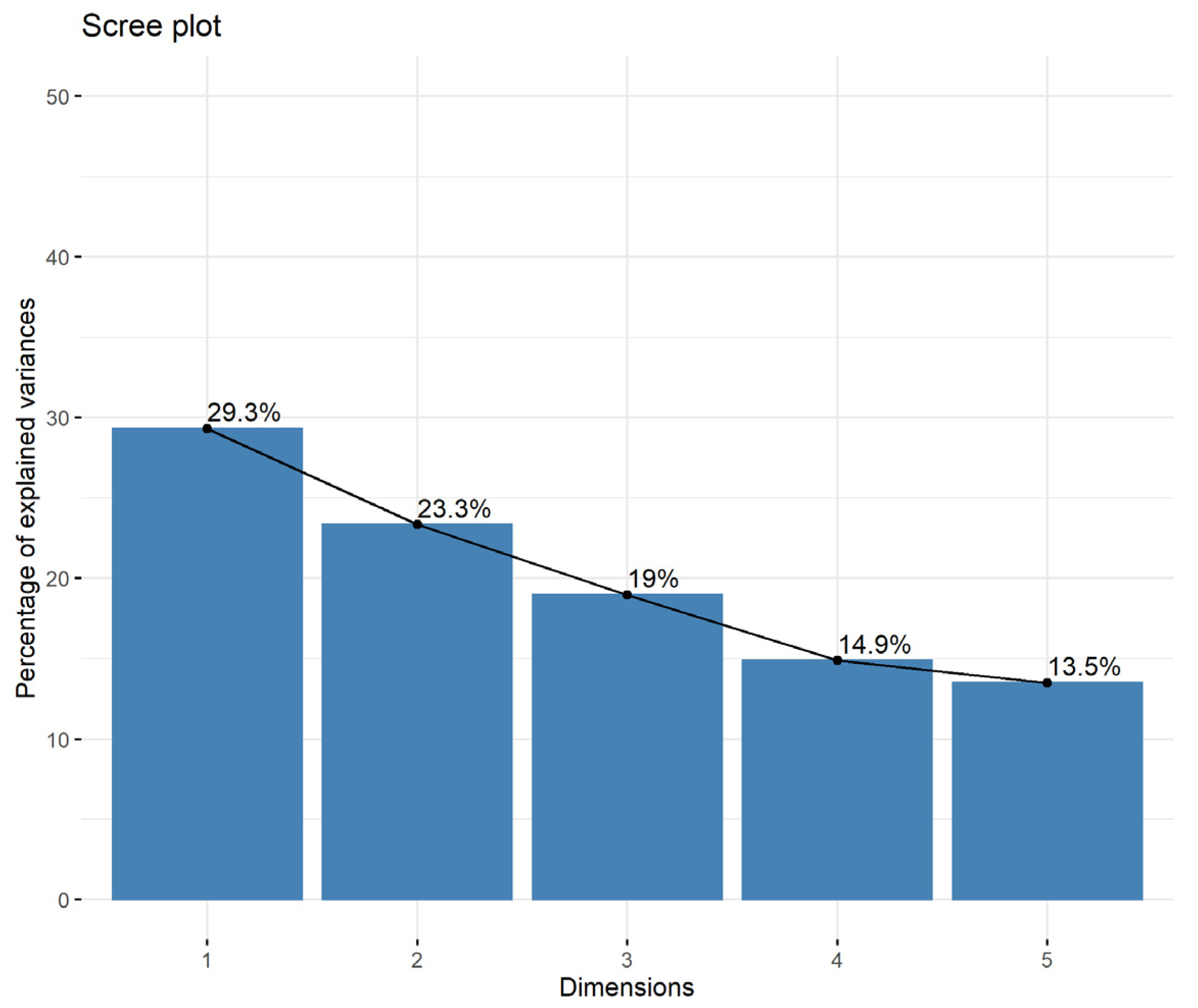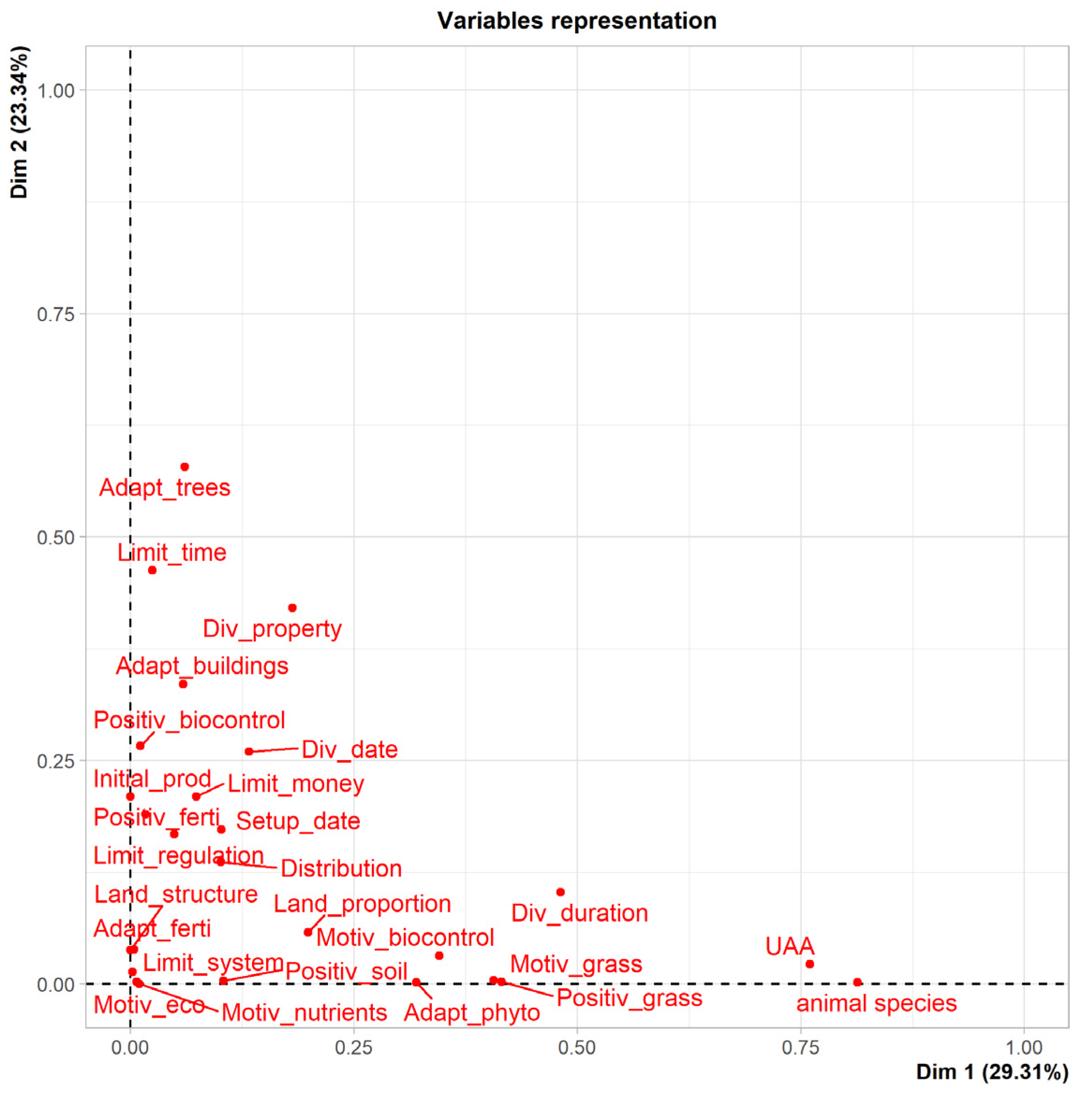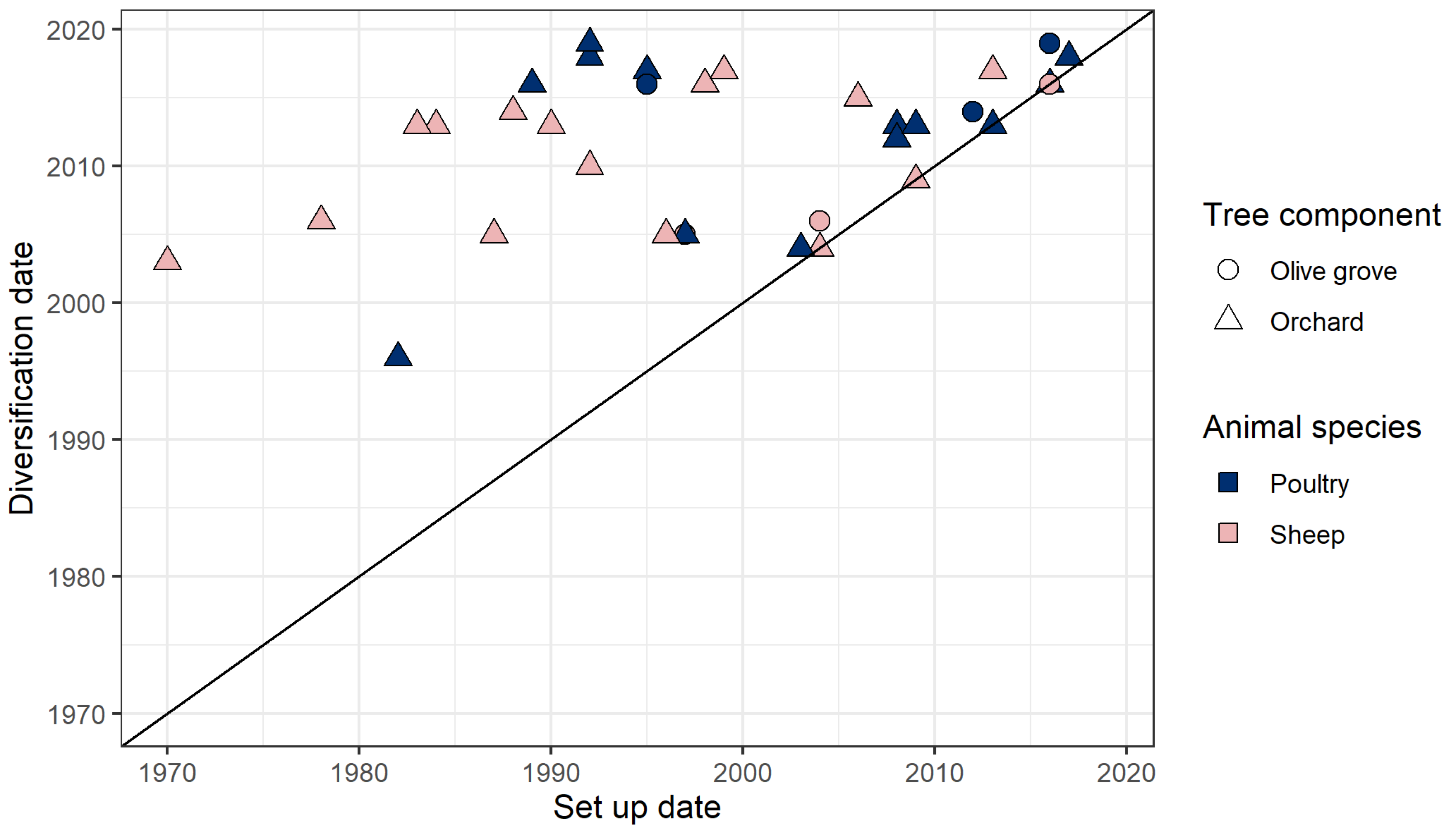Orchard Grazing in France: Multiple Forms of Fruit Tree–Livestock Integration in Line with Farmers’ Objectives and Constraints
Abstract
1. Introduction
2. Materials and Methods
2.1. Identifying and Characterizing a Diversity of Orchard and Livestock Integration
- The focus group “Vergers + Durables” (V + D), 2008–2013 [25,26], which brought together researchers, extensionists, and fruit growers from France, Belgium, Switzerland and Spain; Objective: to analyze different forms of sustainable orchard prototypes and to share experiences; Method: semi-directive interviews; System: sheep grazing in orchards (n = 2 farms).
- The research project “ARDU”, 2014–2016 [27,28]; Objective: to study motivations, determinants and trajectories of producers who implement diversified orchard systems, including grazed orchards [27]; Method: semi-directive interviews and workshops with practitioners and advisors; System: sheep or poultry grazing in orchards (n = 5 farms).
- The agricultural development project, “IRAEE”, 2016 [29,30], which was composed of development actors engaged in farm energy savings; Objective: to study grazed orchard farming system models by substituting some mechanized work with livestock; Method: semi-directive interviews; System: sheep or poultry grazing in orchards (n = 9 farms).
- The action research project “PEI”, 2018–2022 [31], which was composed of agricultural research and development actors; Objective: regional development of pastoralism in perennial crops; Method: semi-directive interviews; System: sheep or poultry grazing in orchards and olive groves (n = 14 farms).
- Diversified orchards surveyed independently of any research and development program (HD); Objective: exploration of different forms of grazed orchard systems; Method: semi-directive interviews; System: sheep or poultry grazing in orchards and olive groves (n = 4 farms).
2.2. Data Processing and Statistical Analysis
2.3. Farm Sample Description
3. Results
3.1. Poultry in Orchards (Group 1)
3.2. Sheep Grazing in Orchard Managed by Fruit Growers (Group 2)
3.3. Sheep Grazing in Orchards in Cooperation with a Shepherd (Group 3)
3.4. Synthesis on Grazed Orchard Management
4. Discussion
4.1. An Exploratory Approach to Record Farmer’s Experiences with Fruit Trees and Livestock Integration
4.2. The Balance between Contraints and Benefits as an Optimal Degree of Integration
4.3. A Gradient of Farm Redesign
5. Conclusions
Author Contributions
Funding
Institutional Review Board Statement
Informed Consent Statement
Data Availability Statement
Acknowledgments
Conflicts of Interest
Appendix A. Results of the Multiple Correspondence Analysis


References
- Herzog, F. Streuobst: A traditional agroforestry system as a model for agroforestry development in temperate Europe. Agrofor. Syst. 1998, 42, 61–80. [Google Scholar] [CrossRef]
- Hilimire, K. Integrated crop/livestock agriculture in the United States: A review. J. Sustain. Agric. 2011, 35, 376–393. [Google Scholar] [CrossRef]
- Burgess, P.; Chinery, F.; Eriksson, G.; Pershagen, E.; Pérez-Casenave, C.; Upson, M.; García de Jalón, S.; Giannitsopoulos, M.; Graves, A. Lessons Learnt—Grazed Orchards in England and Wales. 2017. Available online: https://www.agforward.eu/documents/LessonsLearnt/WP3_UK_grazed_orchards_lessons%20learnt.pdf (accessed on 17 August 2021).
- MacAdam, J.; Ward, F. System Report: Grazed Orchards in Northern Ireland. 2016. Available online: https://www.agforward.eu/documents/WP3_NIUK_Grazed_Orchards_system_description.pdf (accessed on 17 August 2021).
- Bonaudo, T.; Bendahan, A.B.; Sabatier, R.; Ryschawy, J.; Bellon, S.; Leger, F.; Magda, D.; Tichit, M.; Burlamaqui, A.; Sabatier, R.; et al. Agroecological principles for the redesign of integrated crop-livestock systems. Eur. J. Agron. 2014, 57, 43–51. [Google Scholar] [CrossRef]
- Bell, L.W.; Moore, A.D. Integrated crop-livestock systems in Australian agriculture: Trends, drivers and implications. Agric. Syst. 2012, 111, 1–12. [Google Scholar] [CrossRef]
- Mischler, P.; Tresch, P.; Jousseins, C.; Chambaut, H.; Durant, D.; Veysset, P.; Martin, G.; Fiorelli, J.L.; Chedly, H.B.; Pierret, P.; et al. Savoir caractériser les complémentarités entre cultures et élevage pour accompagner la reconception des systèmes de polyculture-élevage dans leurs transitions agroécologiques. In Proceedings of the Rencontres Autour des Recherches sur les Ruminants, Paris, France, 5–6 December 2018; pp. 11–20. [Google Scholar]
- Schiere, J.B.; Ibrahim, M.N.M.M.; Van Keulen, H. The role of livestock for sustainability in mixed farming: Criteria and scenario studies under varying resource allocation. Agric. Ecosyst. Environ. 2002, 90, 139–153. [Google Scholar] [CrossRef]
- Stark, F.; González-García, E.; Navegantes, L.; Miranda, T.; Poccard-Chapuis, R.; Archimède, H.; Moulin, C.H. Crop-livestock integration determines the agroecological performance of mixed farming systems in Latino-Caribbean farms. Agron. Sustain. Dev. 2018, 38, 4. [Google Scholar] [CrossRef]
- Martin, G.; Moraine, M.; Ryschawy, J.; Magne, M.-A.; Asai, M.; Sarthou, J.-P.; Duru, M.; Therond, O. Crop–livestock integration beyond the farm level: A review. Agron. Sustain. Dev. 2016, 36, 53. [Google Scholar] [CrossRef]
- Moraine, M.; Grimaldi, J.; Murgue, C.; Duru, M.; Therond, O. Co-design and assessment of cropping systems for developing crop-livestock integration at the territory level. Agric. Syst. 2016, 147, 87–97. [Google Scholar] [CrossRef]
- Fraser, E.C.; Kabzems, R.; Lieffers, V.J. Sheep grazing for vegetation management in the northern forests of British Columbia and Alberta. For. Chron. 2001, 77, 713–719. [Google Scholar] [CrossRef]
- Den Herder, M.; Moreno, G.; Mosquera-losada, R.; Palma, J.; Sidiropoulou, A.; Javier, J.; Freijanes, S.; Crous-duran, J.; Paulo, J.; Tomé, M.; et al. Current Extent and Trends of Agroforestry in the EU27; AGFORWARD: København, Denmark, 2015; pp. 1–99. [Google Scholar]
- Lavigne, A.; Dumbardon-Martial, E.; Lavigne, C. Poultry for biological control of weeds in orchards. Fruits 2012, 67, 341–351. [Google Scholar] [CrossRef][Green Version]
- Geddes, P.; Kohl, R. Shropshire Sheep Control Weeds in Orchards. Pestic. News 2009, 86, 3–4. [Google Scholar]
- Niles, M.T.; Garrett, R.D.; Walsh, D. Ecological and economic benefits of integrating sheep into viticulture production. Agron. Sustain. Dev. 2018, 38, 1. [Google Scholar] [CrossRef]
- Clark, M.S.; Gage, S.H. Effects of free-range chickens and geese on insect pests and weeds in an agroecosystem. Am. J. Altern. Agric. 1996, 11, 39–47. [Google Scholar] [CrossRef]
- Buehrer, K.A.; Grieshop, M.J. Postharvest grazing of hogs in organic fruit orchards for weed, fruit, and insect pest management. Org. Agric. 2014, 4, 223–232. [Google Scholar] [CrossRef]
- Ginane, C.; Deiss, V.; Bernard, M.; Payen, C.; Beral, C.; Bizeray-Filoche, D. Sheep grazing on wooded pastures: Which effects of trees on animal behaviour, welfare and performance? In Proceedings of the Rencontres Autour des Recherches sur les Ruminants, Paris, France, 5–6 December 2018; pp. 213–217. [Google Scholar]
- Paolotti, L.; Boggia, A.; Castellini, C.; Rocchi, L.; Rosati, A. Combining livestock and tree crops to improve sustainability in agriculture: A case study using the Life Cycle Assessment (LCA) approach. J. Clean. Prod. 2016, 131, 351–363. [Google Scholar] [CrossRef]
- Wilson, L.M.; Hardestry, L.H. Targeted grazing with sheep and goats in orchard settings. In Targeted Grazing: A Natural Approach to Vegetation Management and Landscape Enhancement; American Sheep Industry Association: Englewood, CO, USA, 2006; pp. 99–106. [Google Scholar]
- Hardesty, L.H.; Howell, W. Silvopastoral orchard management options. In Proceedings of the Second Conference on Agroforestry in North America, Springfield, MO, USA, 18–21 August 1991. [Google Scholar]
- Moore, A.; Bell, L.; Thomas, D.; Smith, A. Crop-livestock farming systems in Australia: What levels of integration result in different benefits? In Proceedings of the 5th International Symposium for Farming Systems Design, Montpellier, France, 7–10 September 2015; pp. 225–226. [Google Scholar]
- Lewis-Beck, M.; Bryman, A.; Futing Liao, T. Snowball Sampling. SAGE Encycl. Soc. Sci. Res. Methods 2004. [Google Scholar] [CrossRef]
- Capitaine, M.; Penvern, S.; Cardona, A.; Simmoneaux, J. The “sustainable orchards” group produces and capitalizes knowledge to design and lead orchards otherwise. Agron. Environ. Sociétés 2016, 6, 93–99. [Google Scholar]
- Penvern, S.; Fernique, S.; Cardona, A.; Herz, A.; Ahrenfeldt, E.; Dufils, A.; Jamar, L.; Korsgaard, M.; Kruczyńska, D.; Matray, S.; et al. Farmers’ management of functional biodiversity goes beyond pest management in organic European apple orchards. Agric. Ecosyst. Environ. 2019, 284, 106555. [Google Scholar] [CrossRef]
- Cazaux, L. Determining Factors and Trajectories Analysis to Support System Diversification: Mixed Orchard Animals and Mixed Orchard Vegetables Systems. Master’s Thesis, Norwegian University of Life Sciences, Ås, Norway, 2015. [Google Scholar]
- Lamine, C.; Simon, S.; Audergon, J.M. ARDU. ARboriculture Durable: Approches interdisciplinaires. In Proceedings of the Métaprogramme INRA Gestion Durable de la Santé des Cultures, Paris, France, 6–7 October 2016; p. 21. [Google Scholar]
- Bio de Provence. Le Pâturage en Vergers; Livret de références de l’inter-réseau Agriculture Energie Environnement; Bio de Provence: Avignon, France, 2017. [Google Scholar]
- Colleu, S. Etude REVE: Reconnexion Verger—Élevage, Dossier Documentaire, REVE Project technical Report. 2020. Available online: https://hal.inrae.fr/hal-03196032/document (accessed on 17 August 2021).
- Pei Depasse Intégrer des Animaux aux Cultures Pérennes. Une Démarche Agro-écologique à Accompagner en Provence-Alpes-Côte d’Azur. 2018. Available online: https://www.google.com.hk/url?sa=t&rct=j&q=&esrc=s&source=web&cd=&ved=2ahUKEwjehbCz26XzAhU2QPUHHXSQAYgQFnoECAQQAQ&url=http%3A%2F%2Fwww.grab.fr%2Fwp-content%2Fuploads%2F2018%2F09%2Fplaquette-depasse-V8.pdf&usg=AOvVaw1rJbJPltS86jhJ1SLpBhlw (accessed on 18 August 2021).
- Hendrickson, J.R.; Hanson, J.D.; Tanaka, D.L.; Sassenrath, G. Principles of integrated agricultural systems: Introduction to processes and definition. Renew. Agric. Food Syst. 2008, 23, 265–271. [Google Scholar] [CrossRef]
- Husson, F.; Josse, J. Multiple Correspondence Analysus. In Visualization and Verbalization of Data; Blasius, J., Greenacre, M., Eds.; CRC Press: Boca Raton, FL, USA, 2014; pp. 165–183. [Google Scholar]
- Husson, F.; Lê, S.; Pagès, J. Exploratory Multivariate Analysis by Example Using R; CRC Press: Boca Raton, FL, USA, 2010; ISBN 978-1439835807. [Google Scholar]
- R Core Team. R: A Language and Environment for Statistical Computing; R Foundation for Statistical Computing: Vienna, Austria, 2020. [Google Scholar]
- Lê, S.; Josse, J.; Husson, F. FactoMineR: An R Package for Multivariate Analysis. J. Stat. Softw. 2008, 25, 18–35. [Google Scholar] [CrossRef]
- Pantera, A.; Burgess, P.J.; Mosquera Losada, R.; Moreno, G.; López-Díaz, M.L.; Corroyer, N.; McAdam, J.; Rosati, A.; Papadopoulos, A.M.; Graves, A.; et al. Agroforestry for high value tree systems in Europe. Agrofor. Syst. 2018, 92, 945–959. [Google Scholar] [CrossRef]
- Conrad, L.; Henke, M.; Hoerl, J.; Luick, R.; Schoof, N. “Vineyard sheep”: Suitability of different breeds and possible breeding objectives. Erichte Uber Landwirtsch. 2020, 98, 18. [Google Scholar]
- Bijja, M.; Arroyo, J.; Lavigne, F.; Dubois, J.P.; Fortun-Lamothe, L. Les services rendus par les systèmes de production de foie gras agroforestiers: L’exemple de l’association entre oies et noyers en Périgord. Prod. Anim. 2017, 30, 241–254. [Google Scholar] [CrossRef]
- Martel, G.; Guilbert, C.; Veysset, P.; Dieulot, R.; Durant, D.; Mischler, P. Effectively combining crop and livestock systems on conventional and organic farms: A means for increasing system sustainability? Fourrages 2017, 231, 235–245. [Google Scholar]
- Ryschawy, J.; Choisis, N.; Choisis, J.P.; Joannon, A.; Gibon, A. Mixed crop-livestock systems: An economic and environmental-friendly way of farming? Animal 2012, 6, 1722–1730. [Google Scholar] [CrossRef] [PubMed]
- Pissonnier, S.; Dufils, A.; Le Gal, P.Y. A methodology for redesigning agroecological radical production systems at the farm level. Agric. Syst. 2019, 173, 161–171. [Google Scholar] [CrossRef]
- Chantre, E.; Cerf, M.; Le Bail, M. Transitional pathways towards input reduction on French field crop farms. Int. J. Agric. Sustain. 2015, 13, 69–86. [Google Scholar] [CrossRef]
- Mawois, M.; Vidal, A.; Revoyron, E.; Casagrande, M.; Jeuffroy, M.H.; Le Bail, M. Transition to legume-based farming systems requires stable outlets, learning, and peer-networking. Agron. Sustain. Dev. 2019, 39, 14. [Google Scholar] [CrossRef]
- Lamine, C. Transition pathways towards a robust ecologization of agriculture and the need for system redesign. Cases from organic farming and IPM. J. Rural Stud. 2011, 27, 209–219. [Google Scholar] [CrossRef]
- Catalogna, M.; Dubois, M.; Navarrete, M. Diversity of experimentation by farmers engaged in agroecology. Agron. Sustain. Dev. 2018, 38, 50. [Google Scholar] [CrossRef]
- Kronberg, S.L.; Ryschawy, J. Integration of Crop and Livestock Production in Temperate Regions to Improve Agroecosystem Functioning, Ecosystem Services, and Human Nutrition and Health; Elsevier Inc.: Amsterdam, The Netherlands, 2018; ISBN 9780128110508. [Google Scholar]
- Moraine, M.; Duru, M.; Thérond, O. Un cadre conceptuel pour l’intégration agroécologique de systèmes combinant culture et élevage. Innov. Agron. 2012, 22, 101–115. [Google Scholar]
- Paut, R.; Sabatier, R.; Dufils, A.; Tchamitchian, M. How to reconcile short-term and long-term objectives in mixed farms? A dynamic model application to mixed fruit tree—Vegetable systems. Agric. Syst. 2021, 187, 103011. [Google Scholar] [CrossRef]
- Do, H.; Luedeling, E.; Whitney, C. Decision analysis of agroforestry options reveals adoption risks for resource-poor farmers. Agron. Sustain. Dev. 2020, 40, 20. [Google Scholar] [CrossRef]
- Sabatier, R.; Doyen, L.; Tichit, M. Action versus result-oriented schemes in a Grassland agroecosystem: A dynamic modelling approach. PLoS ONE 2012, 7, e33257. [Google Scholar] [CrossRef] [PubMed]
- Moraine, M.; Melac, P.; Ryschawy, J.; Duru, M.; Therond, O. A participatory method for the design and integrated assessment of crop-livestock systems in farmers ’ groups. Ecol. Indic. 2017, 72, 340–351. [Google Scholar] [CrossRef]
- Asai, M.; Moraine, M.; Ryschawy, J.; de Wit, J.; Hoshide, A.K.; Martin, G. Critical factors for crop-livestock integration beyond the farm level: A cross-analysis of worldwide case studies. Land Use Policy 2018, 73, 184–194. [Google Scholar] [CrossRef]
- Hill, S.B.; MacRae, R.J. Conceptual Framework for the Transition from Conventional to Sustainable Agriculture. J. Sustain. Agric. 1996, 7, 81–87. [Google Scholar] [CrossRef]
- Trouillard, M.; Bérud, M.; Dufils, A.; Lèbre, A.; Heckendorn, F. Sheep Grazing Organic Vineyards And Orchards: What About Copper Poisoning? In Proceedings of the 6th ISOFAR Conference, Rennes, France, 8–10 September 2021. [Google Scholar]
- Birner, R.; Davis, K.; Pender, J.; Nkonya, E.; Anandajayasekeram, P.; Ekboir, J.; Mbabu, A.; Spielman, D.J.; Horna, D.; Benin, S.; et al. From Best Practice to Best Fit: A Framework for Designing and Analyzing Pluralistic Agricultural Advisory Services Worldwide. J. Agric. Educ. Ext. 2009, 15, 341–355. [Google Scholar] [CrossRef]
- Bakker, T.; Dugué, P.; de Tourdonnet, S. Assessing the effects of Farmer Field Schools on farmers’ trajectories of change in practices. Agron. Sustain. Dev. 2021, 41, 18. [Google Scholar] [CrossRef]



| Group Description | Variables | Code | Modalities |
|---|---|---|---|
| Farm structural descriptors | Tree component | initial_prod | Orchard, Olive grove |
| Livestock component | animal_species | Poultry, Sheep | |
| Utilized Agricultural Area (UAA) used for tree-livestock integration (ha) | UAA | Small (<5 ha); medium (5–20 ha), large (>20 ha) | |
| Land structure | Land_structure | Merged, Fragmented | |
| Time since tree–livestock integration (years) | Div_date | <2005, 2005–2015, >2015 | |
| Ownership of livestock | Div_property | Yes, No, Both | |
| Farmers’ motivations | Economic motivation | Motiv_eco | Yes, No |
| Grass management motivation | Motiv_grass | Yes, No | |
| Biological control motivation | Motiv_biocontrol | Yes, No | |
| Improving nutrient recycling motivation | Motiv_nutrients | Yes, No | |
| Technical adaptations | Adaptation of tree management practices (training, pruning, shaping) | Adapt_trees | Yes, No |
| Adaptation of fertilization practices (modification or reduction of doses) | Adapt_ferti | Yes, No | |
| Adaptation of phytosanitary practices (postponement of treatment, reduction, or substitution of products) | Adapt_phyto | Yes, No | |
| Adaptation of farm buildings (irrigation, trellising) | Adapt_buildings | Yes, No | |
| Temporality of tree-livestock integration | Div_duration | Permanent, Temporary | |
| Proportion of land diversified within the farm | Land_proportion | All, Part | |
| Benefits and disadvantages | Biological control | Positiv_biocontrol | Yes, No |
| Grass management | Positiv_grass | Yes, No | |
| Soil fertility improvement | Positiv_soil | Yes, No | |
| Time constraint | Limit_time | Yes, No | |
| Financial investment constraint | Limit_money | Yes, No |
| Characteristics | Benefits | Limits | |
|---|---|---|---|
| Livestock management by fruit growers | Owner of both activities | Flexible management Economic valuation of livestock | Investments Plot structuring Sanitary regulations Workload |
| Partnership between fruit grower and herder | Possibility to delegate the entire livestock farming management (no skills required) | Appropriate grazing area Communication and coordination between farmers Adapting orchard operations to the herder’s organization | |
| Grazing temporality under trees | Permanent grazing | Better efficiency of grazing and prophylaxis | Grass resource Tree training Animal parasitism Reduction in floral diversity |
| Temporary grazing | Simplification of orchard management | Need for fallback plots | |
Publisher’s Note: MDPI stays neutral with regard to jurisdictional claims in published maps and institutional affiliations. |
© 2021 by the authors. Licensee MDPI, Basel, Switzerland. This article is an open access article distributed under the terms and conditions of the Creative Commons Attribution (CC BY) license (https://creativecommons.org/licenses/by/4.0/).
Share and Cite
Paut, R.; Dufils, A.; Derbez, F.; Dossin, A.-L.; Penvern, S. Orchard Grazing in France: Multiple Forms of Fruit Tree–Livestock Integration in Line with Farmers’ Objectives and Constraints. Forests 2021, 12, 1339. https://doi.org/10.3390/f12101339
Paut R, Dufils A, Derbez F, Dossin A-L, Penvern S. Orchard Grazing in France: Multiple Forms of Fruit Tree–Livestock Integration in Line with Farmers’ Objectives and Constraints. Forests. 2021; 12(10):1339. https://doi.org/10.3390/f12101339
Chicago/Turabian StylePaut, Raphaël, Arnaud Dufils, Floriane Derbez, Anne-Laure Dossin, and Servane Penvern. 2021. "Orchard Grazing in France: Multiple Forms of Fruit Tree–Livestock Integration in Line with Farmers’ Objectives and Constraints" Forests 12, no. 10: 1339. https://doi.org/10.3390/f12101339
APA StylePaut, R., Dufils, A., Derbez, F., Dossin, A.-L., & Penvern, S. (2021). Orchard Grazing in France: Multiple Forms of Fruit Tree–Livestock Integration in Line with Farmers’ Objectives and Constraints. Forests, 12(10), 1339. https://doi.org/10.3390/f12101339






